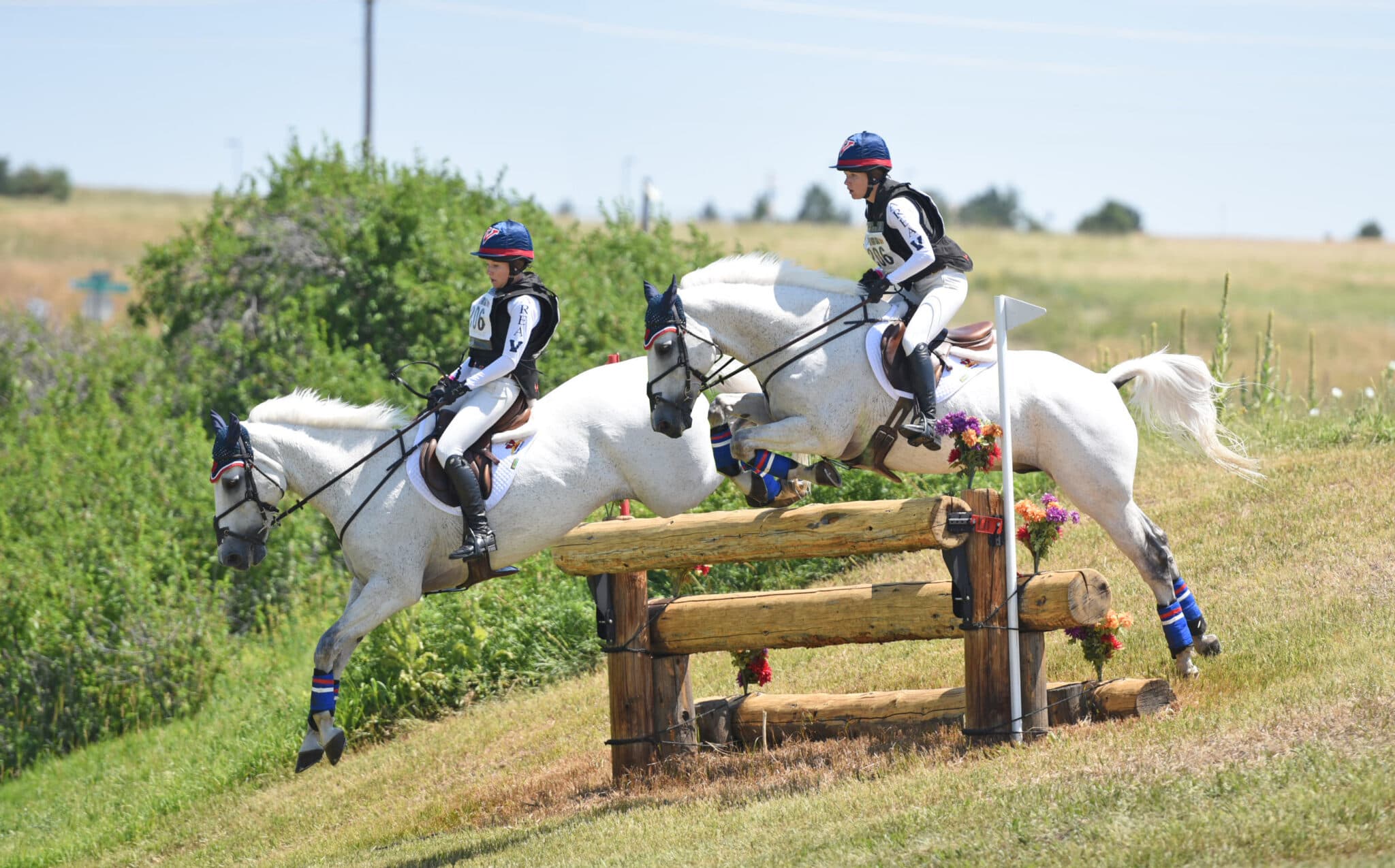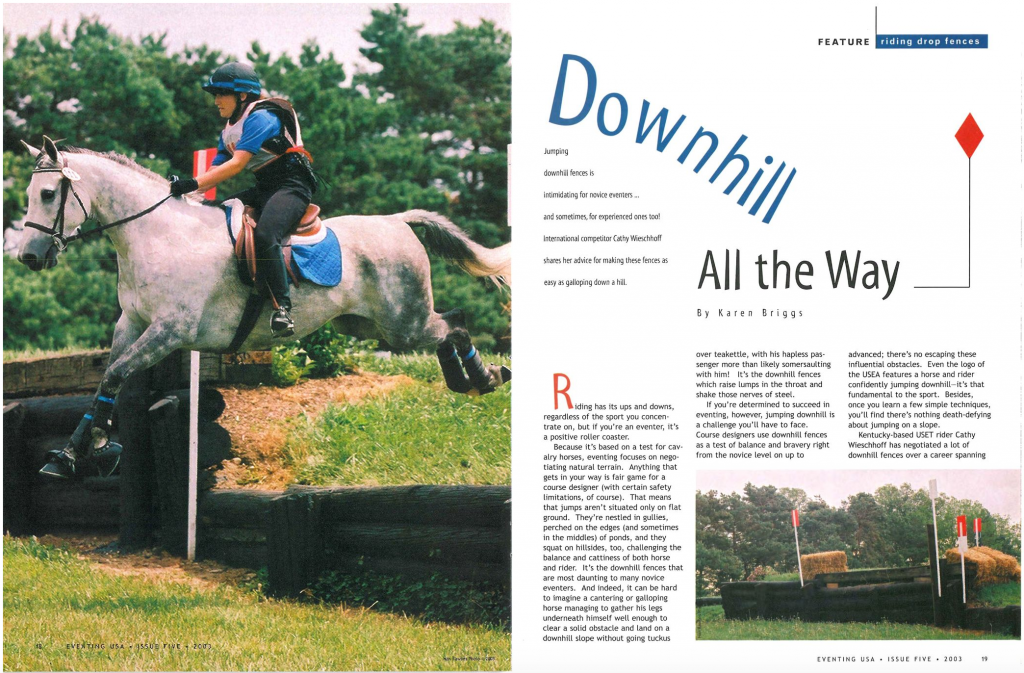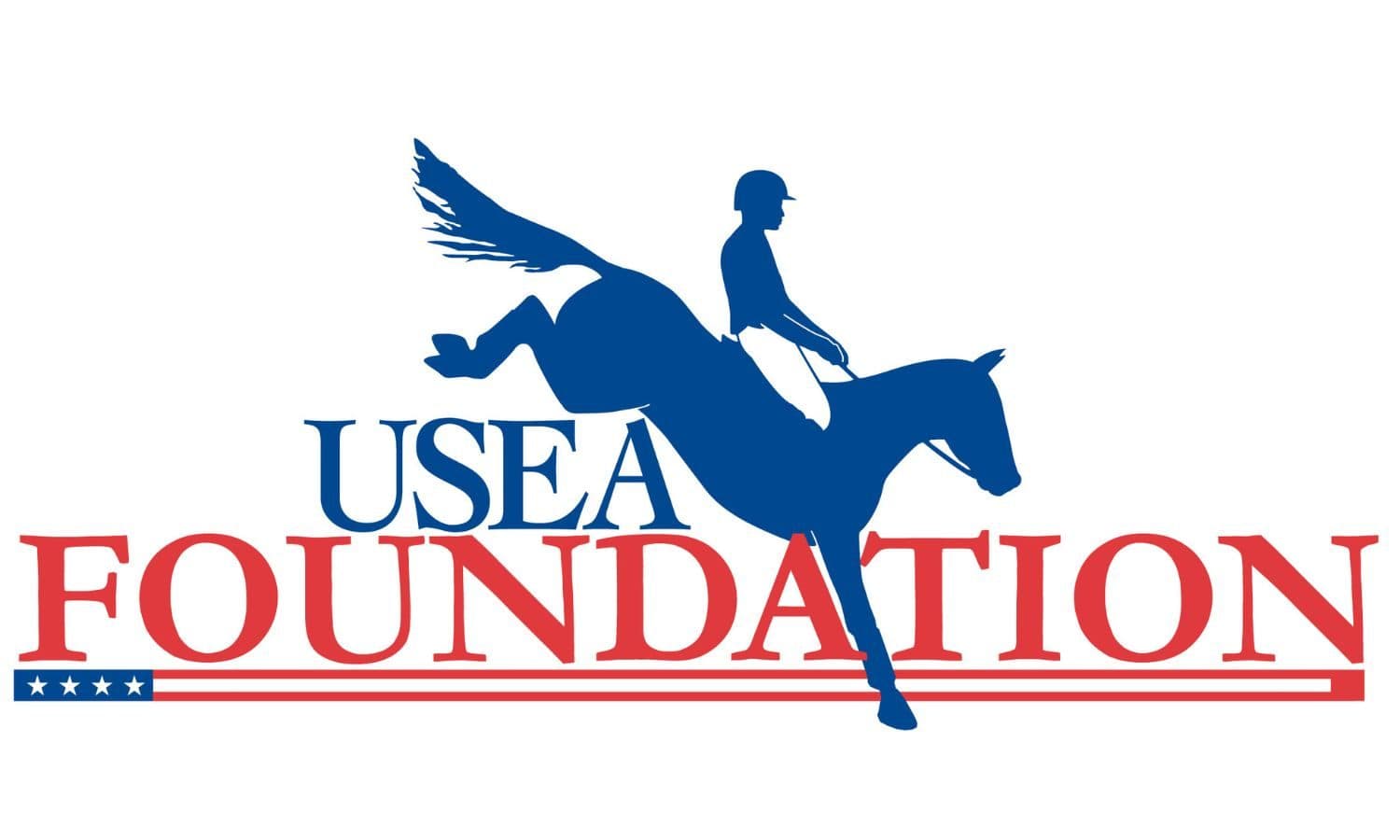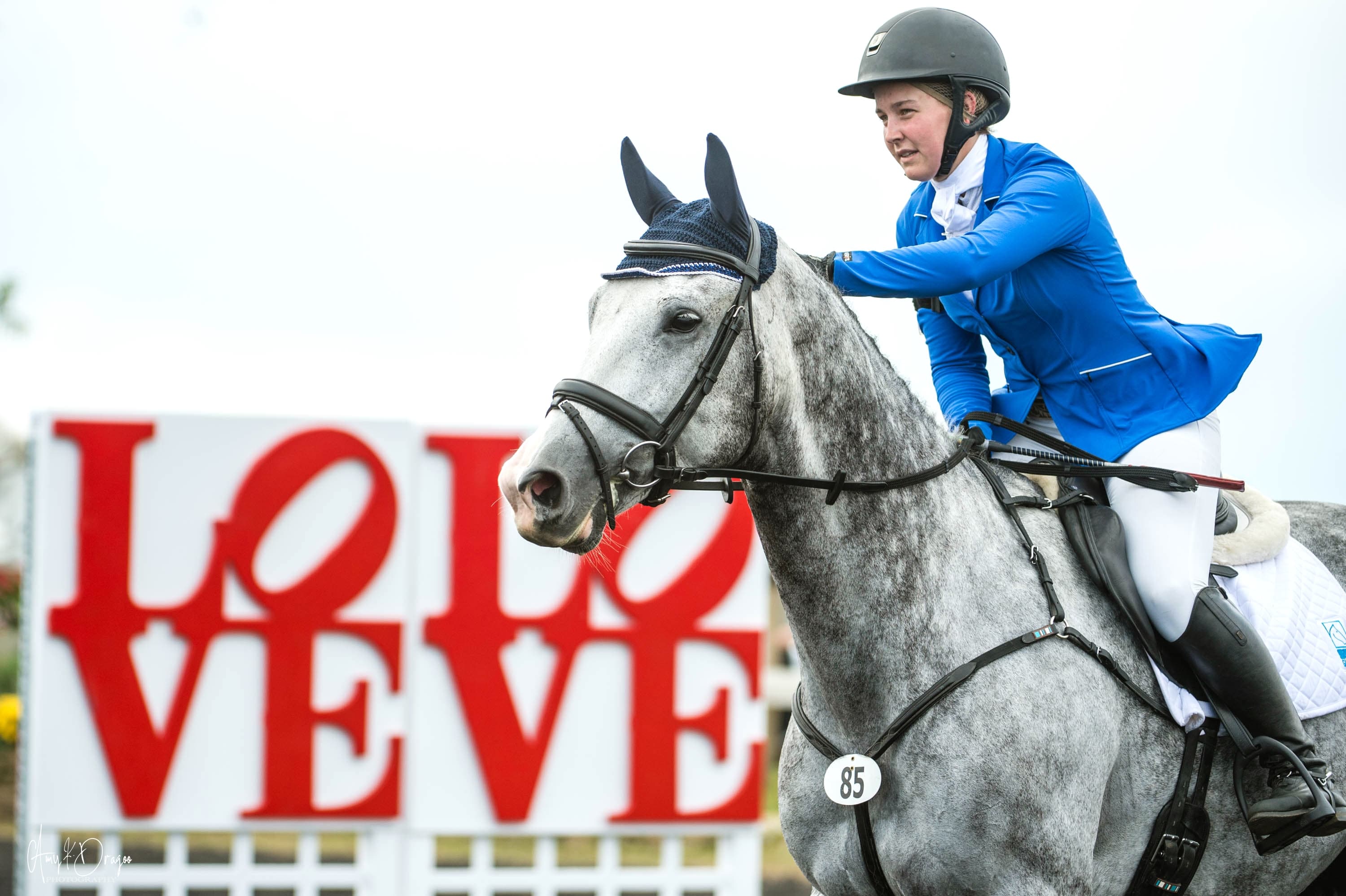Throwback Thursday Presented by the USEA Foundation: Downhill All the Way, Conquer Downhill Fences

This article originally appeared in Volume 32, Issue 5 of Eventing USA.
Riding has its ups and downs, regardless of the sport you concentrate on, but if you're an eventer, it's a positive roller coaster. Because it's based on a test for cavalry horses, eventing focuses on negotiating natural terrain. Anything that gets in your way is fair game for a course designer (with certain safety limitations, of course). That means that jumps aren't situated only on flat ground. They're nestled in gullies, perched on the edges (and sometimes in the middles) of ponds, and they squat on hillsides, too, challenging the balance and cattiness of both horse and rider. It's the downhill fences that are most daunting to many novice eventers. And indeed, it can be hard to imagine a cantering or galloping horse managing to gather his legs underneath himself well enough to clear a solid obstacle and land on a downhill slope without going tuckus over teakettle, with his hapless passenger more than likely somersaulting with him! It's the downhill fences which raise lumps in the throat and shake those nerves of steel.
If you're determined to succeed in eventing, however, jumping downhill is a challenge you'll have to face. Course designers use downhill fences as a test of balance and bravery right from the novice level on up to advanced; there's no escaping these influential obstacles. Even the logo of the USEA features a horse and rider confidently jumping downhill- it's that fundamental to the sport. Besides, once you learn a few simple techniques, you'll find there's nothing death-defying about jumping on a slope.
Kentucky-based USET rider Cathy Wieschhoff has negotiated a lot of downhill fences over a career spanning 20 years and more than a dozen international competitions, including the Rolex Kentucky CCI****, the Burghley Horse Trials, and the Eventing World Championships. In her capacity as a coach, she has also introduced a lot of riders to the intricacies of negotiating sloping terrain.


Baby Steps
"You've got to be comfortable riding downhill, without a fence, first," Cathy says. "Those are the basic basics. Your horse has to be able to balance himself. Start by riding down gentle slopes, to teach your horse to carry his weight on his hind end, and do lots of transitions on the slopes, from walk to trot and back to walk for example, to encourage him to use his hindquarters. To begin with, your horse will likely get quick, or heavy in your hands, or both- so I find it's useful to walk a circle, on a gradual slope. This lets your horse regain his balance on the uphill side of the circle and then be challenged again as he heads downhill. Once you feel reasonably balanced on a gradual slope, you can work up to more difficult downhills. And when you're comfortable with walking and trotting those slopes, you can introduce cantering."
Horses learn by repetition, Cathy emphasizes, so it's important not to skip over this early work. "It's also crucial that when you get to the bot tom of the hill, you don't let him get quick as he hits the level ground. He has to learn to wait for you, to wait for the transition. If you establish good habits from the start, you won't have to fight with him later."
The next step in the program is to introduce a very small fence. If you're not lucky enough to have a novice-sized downhill cross-country fence at your disposal, find a suitable gentle slope and truck out a portable stadium fence, or even a single cavaletti. "You're practicing the skills," Cathy says, "so the size of the fence isn't the issue. Even with my advanced horses I don't school downhill fences that are any more than 3' or 3'3". What you're really doing is incorporating your flatwork into your jumping routine."
Before you jump your downhill fence for the first time, you'll need to establish a defensive jumping position, which is a little different than the position you'd use for flat terrain. "I don't necessarily advocate leaning back," says Cathy, "so much as just being in balance and staying in your comfort zone." That means keeping your upper body over your horse's center of gravity so that when he lands downhill, you won't encourage him to speed up by being ahead of the motion. Over a small fence on a gentle downhill slope, most riders won't need to lean back; they'll just find an extra measure of security in parking their lower legs slightly forward, "on the dashboard," and in allowing their horses a little extra length of rein so they can balance effectively with the head and neck. The larger the fence is, and the more severe the slope, the more most riders will need to lean back in the air ... but this also depends on your individual body type.
"If you watch videos of top riders, you'll notice quite a number of different styles, depending on the length of the arms and the upper body. Blyth Tait, for example, leans way back on a drop fence, but he's quite compactly built ... whereas a taller rider, with longer arms, like Ian Stark, seems to move much less. Both are extremely effective riders, and both are in balance with their horses. By watching other riders, you can begin to develop your own style," Cathy says.
What's more important than how much you move your upper body backwards is your hand position. "There's a common misconception about how much you should 'give' up the horse's neck," Cathy says. "With a downhill fence, what you need to do is keep your hands low and close to the breastplate or the martingale strap. The trouble with doing a big 'give' up the horse's neck is that it throws your upper body forward, and that can put both of you out of balance on the landing. You'll land in a much better balance if you just concentrate on keeping your hands low and following the mouth."
Faced with the comparative complexity of remembering all this while trotting or cantering down to a downhill fence, many riders have a tendency to freeze up. "[Downhill fences] are definitely an increased balance question for riders, and sometimes they get frightened if the horse speeds up, or leaves very long or short to the fence. That tension can escalate when the rider is staring too far ahead. You may have been told to look up, not down the hill, and that's good-but you don't need to stare into the clouds! If your eyes are too far up, you'll be stiff in your back, and then if your horse decides to leave long, you'll be seriously jolted." Instead, Cathy suggests that you practice being adjustable with your eyes. "Look across the fence, to where you're heading next, not miles away. And think about having springs in your knees, so that when your horse lands, you absorb the impact rather than trying to brace against it. This is especially important in case your horse should stumble or peck on the landing."
If you're really unsure and nervous about your balance the first few times jumping a downhill fence, don't be afraid to call on some extra security. Grab the breastplate or martingale strap with one hand, or bridge your reins so that "you have the bridge to land on," Cathy says.
It should only take a few practice runs over your tiny introductory fence to begin to get the rhythm of jumping downhill. Fortunately, most horses don't find it nearly as daunting as their riders! While you're practicing, remember that, as Cathy says, "you need more engine than speed." When you're comfortable with a single crossrail or vertical, try a small oxer, and then work your way up to this exercise: "Set up a line of two or three fences on a slope, all of which can be jumped going both uphill and downhill. Practice riding them all in a line as well as in a figure-eight, looping downhill for one fence and then turning and going uphill for the next." While you're doing this, Cathy says, concentrate on "getting the same type of balance and rhythm you had when you rode the slope without the jumps."
Though you'll probably find yourself focusing on the take-off when you school downhill fences, don't forget to think about what happens on the landing. When horses do lose their balance and "peck" on downhill fences, it's generally not the landing stride, but the next one (the recovery stride), on which they stumble. So your job isn't finished until you've successfully ridden the landing AND the stride after. "Both of those must be taken care of before you can relax and say that fence is over," emphasizes Cathy.

Drops can be very small to start. USEA/Leslie Mintz Photo.
The Disciplined Downhill
On a cross-country course, downhill fences can take a number of forms. There are simple fences, such as a log, situated on a slope ... and then there are the more intimidating variety, like ski jumps (generally a solid sloping ramp with a downhill landing) . "A ski jump is a question for the eye," Cathy says. "It's really an exercise to make the rider look to the middle of the fence. You have to get close to the base with a fence like this; you don't want to do a huge leap or you'll end up hanging in space forever." (This not only wastes seconds but the resulting impact on your horse's legs may be that much more severe.) "Be disciplined when you ride these," she recommends. "look to the middle of the fence, about halfway up ... then, when you're two or three strides away, lift your eye and look where you're headed."
When riding to any downhill fence, it's a good idea to maintain a feel on your horse's mouth till you're in the air. "If your reins get long before the fence, your horse could get strung out, which means he won't have his quarters underneath him when he needs to jump. If you're going to ride downhill fences, you should have enough coordination to be able to slip the reins in the air, so he can stretch out his neck for the landing. Get comfortable with this at home," says Cathy.
If you and your horse have trouble finding a good spot to a ski jump, do some schooling at home with placing rails. 'The closer your horse gets (to the base), the safer both you and he will be," Cathy says. "Use a placing rail to keep your horse from launching himself early, and then gradually roll the rail in by a few inches to practice getting to the base."
Drop fences, which usually take the form of a bank or platform with a "step" down, are another form of downhill obstacle you'll encounter right from novice on up. As you progress through the levels, the size of the drop increases, but the technique remains the same. "The most important difference with these fences is he degree of impulsion," says Cathy. "You need much less, almost none, in fact, to jump down a bank. You can approach them slowly-when you're training, do them in trot- and then lower your hands, let your horse look at what he's doing, and then gently pop down." The take-home message? Don't panic! Be patient, allow your horse a moment to sort out the question in his head, keep your eyes up and your legs on, and then slip your reins through your fingers as he jumps down.
"You don't want to hustle him or hang onto his mouth, because you'll end up being launched into space," Cathy says. "Once you teach your horse to leap off banks, you're going to be in trouble, because sooner or later you'll encounter a bank which is a part of a combination fence, and the distances won' t ride correctly.
"If you're finding this is a problem, try riding a bank with a placing rail about 15 feet on the Ianding side. This will get the horse to focus on the ground. Gradually move the rail in till it's only about nine feet from the base. Always remember that you don't need to chase him down the bank."
As you and your horse progress through the levels of competition, the downhill questions you'll face will become more complex. Course designers up the ante by increasing the height and width of the fences, making the faces narrower, and adding combinations (for example, you might have to jump up onto a bank, down off it a stride later, and then ride a bending three-stride line to a vertical). Narrow faces demand honesty of your horse and a straight approach from you. "If you approach it wrong, you'll end up with a run-out," says Cathy. "You need to learn to react quickly, and that comes from schooling at home."
Downhill fences lose their intimidating image once you break the task down into manageable steps. Cathy reiterates the important points:
• School on the flat on a hillside to improve your comfort level
• Add jumps as you go and incorporate them into your flatwork
• Engine (impulsion) without speed
• Get close to the base for safety
• Ride the landing AND the stride after it.
If you can do that, it's downhill all the way!














